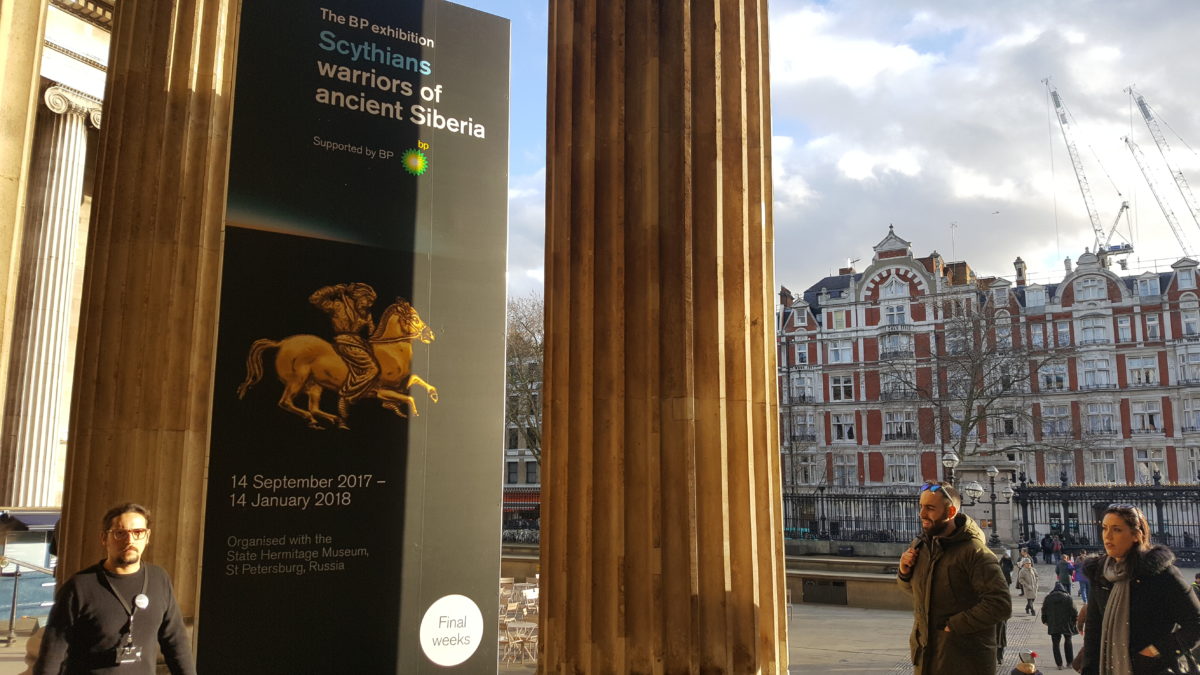Scythians: warriors from ancient Siberia – British Museum, London //Last Chance to See//
Let me preface this by saying I’m a massive (and proud) history geek, but it’s hard to underestimate how impressive it is seeing all of the bits usually missing from archaeological exhibitions and museum displays. The wood, the fabrics, the leather, the hair: the things that are normally inferred from the lack of them (an imprint of fabric left behind, an empty metal fitting) rather than studied and presented to the present-day viewer.
The British Museum’s exhibition Scythians: warriors of ancient Siberia is different thanks to the luxury of permafrost. Permafrost which influenced the burial practices of the Scythians (those who died when the ground was too hard to dig in were mummified until warmer weather, for example), but which then preserved buried clothes, furniture, even tattooed flesh and pierced earlobes.* This is carefully explained throughout the exhibition, which does a good job of balancing informative details on the lives and culture of the Scythians, glimpses of the network of ancient civilisations within which they operated (many quotes from Herodotus and others on the walls as well as some evidence of trade links), the historical context of increased expansion into Siberia and subsequent collection of artefacts for Peter the Great’s kunstkamera, and the science of preserving and studying the objects themselves.

The exhibition opens with a large wall display breaking down the imagery of a typical item of collected Scythian functional art: a gold belt buckle. Through it we learn that the Scythians had no written language, so much has been extrapolated from such imagery. We see what the Scythians wore, the weapons they used, the animals they owned, and something of death within Scythian culture. Given that, as above, the majority of the items in the exhibition were once grave goods, this is an important point. The next room sets the scene of the rediscovery of the Scythians in the eighteenth century: artworks depicting Peter the Great and his various palaces, as well as some of the drawings of artefacts he commissioned juxtaposed with the real deal. The exhibition is organised with the State Hermitage Museum in Russia, and there’s something to be said for royal collections which have become national collections: the layered interweaving of the stories of the object in its original life and the object as data carrier, to borrow from Peter van Mensch, adds a real richness. Accessible text panels, as well as ones aimed at families and children, help visitors to dip in and out of this narrative. Not everyone is as much of an archaeology geek as me, but I think everyone who came must have learned something!
Another aspect of the exhibition which I enjoyed was the design. Let’s face it, a lot of the artefacts (belt buckles, jewellery, gold decorations for clothing) are quite small and fiddly, with many people clustered around trying to get a good look. What contrasts with this is the large-scale backdrops which give a sense of open space, as well as reuniting the objects, at least in atmosphere, with the open steppes and other landscapes they originated in (the Scythians were actually a number of similar groups who lived over a broad sweep of land from the Black Sea coast to modern-day Mongolia, so there would have been a bit of everything landscape-wise). As well as a large projection of a painted panorama from the construction of the Trans-Siberian railway, there are computer-generated or enhanced images placing rock art back in context, or showing the horse equipment and riders’ costumes as they might have been thousands of years ago. Sounds of the natural world help to extend the illusion without being too invasive.
So if you’re in the vicinity of the British museum this week, I would recommend a trip to see Scythians. It’s interesting, informative, less politically-driven than some things I’ve seen in the same hallowed halls, and a chance to feel closer to understanding an ancient people by seeing more of their material culture than is usually possible.
Ends 14 January 2018

*There’s a note in the first room warning visitors of the presence of human remains in the exhibition and referring them to the museum’s policy on such displays. I wonder if there were any modern people who felt affiliated to the ancient Scythians whether the nature of what’s on display would be any more problematic?

